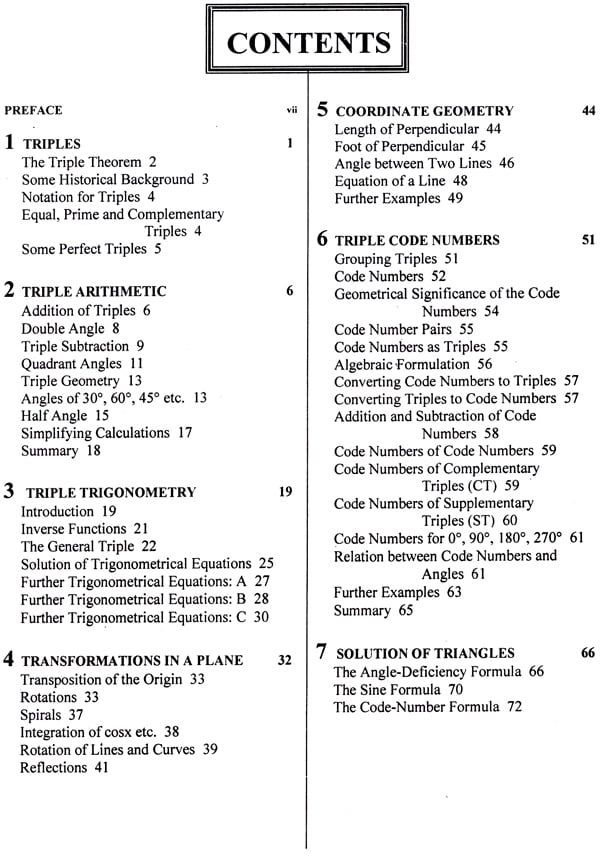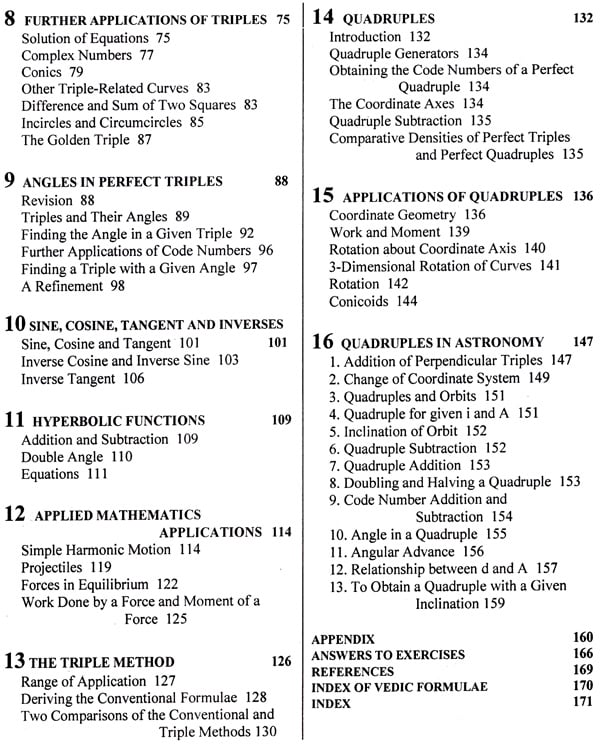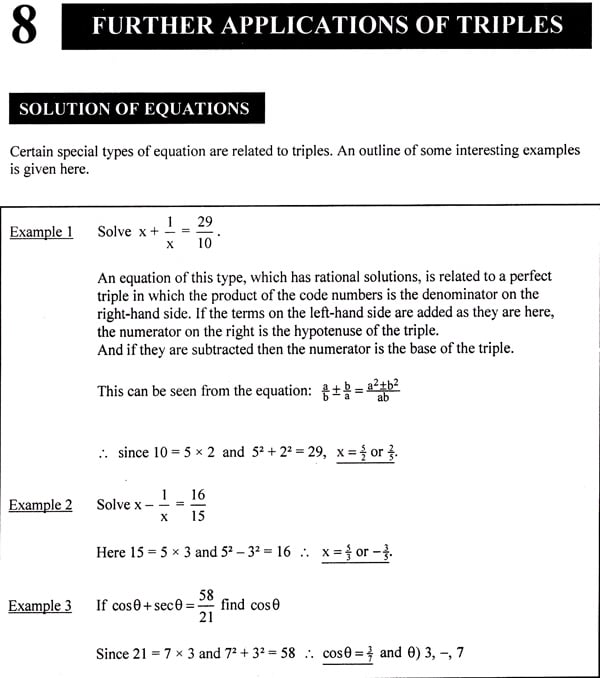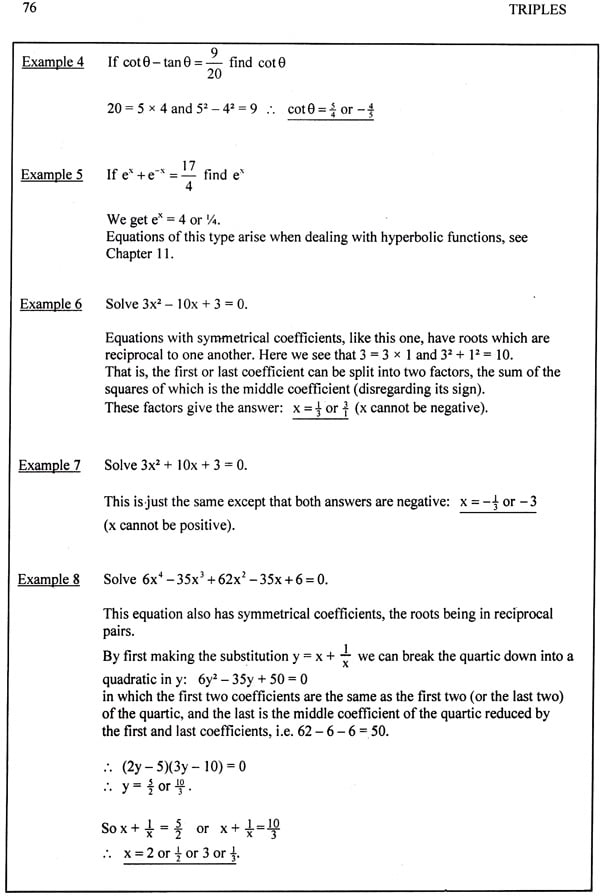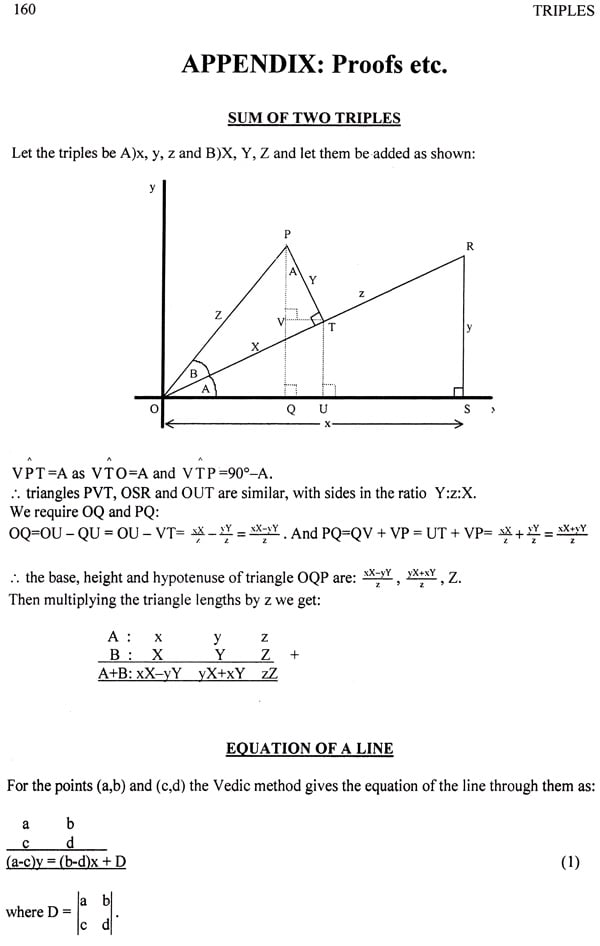
Triples (Applications of Pythagorean Triples)
Book Specification
| Item Code: | NAR352 |
| Author: | Kenneth Williams |
| Publisher: | Motilal Banarsidass Publishers Pvt. Ltd. |
| Language: | English |
| Edition: | 2009 |
| ISBN: | 9788120819580 |
| Pages: | 188 |
| Cover: | PAPERBACK |
| Other Details | 9.50 X 6.50 inch |
| Weight | 310 gm |
Book Description
Pythagorean triples, like 3, 4, and 5 have been a fascination for thousands of years. Now for the first time a simple elegant system, based on these triples, has been developed which reveals unexpected applications in many areas of pure and applied mathematics. These include general applications in trigonometry, coordinate geometry (in 2 and 3 dimensions), transformations (in 2 and 3 dimensions), simple harmonic motion, astronomy etc.
The easy triple method links these areas and replaces large numbers of apparently unconnected formulae with a single device.
This book fully explains the various applications and most of it should be accessible to anyone with the basic understanding of mathematics which a school leaver should have.
KENNETH WILLIAMS has taught Vedic mathematics at several colleges and schools in the UK, has been researching Vedic mathematics since 1971 and has written fifteen books on the subject covering a wide range of topics. He has given many courses/seminars/talks around the world and has done a great deal to disseminate and promote Vedic Mathematics as well as opening up many new areas of research.
The unchanging laws of number have always been a source of delight and inspiration. Particularly attractive are the Pythagorean triples which have so many elegant and interesting properties. But these triples are also of great practical use: through the theorem of Pythagoras the triples link the three main branches of mathematics: number, algebra and geometry.
This appears to be the first time that these triples have been developed into a useful structure, having applications in trigonometry, transformations in 2 and 3 dimensions, coordinate geometry in 2 and 3 dimensions, solution of triangles and equations, complex numbers, hyperbolic functions, simple harmonic motion, astronomy etc. Many more applications are also likely to appear. This book shows how the triples (and their 3-dimensional equivalent, quadruples) can be developed and applied and how they form a unifying thread linking many areas of mathematics.
Several chapters from previous editions of this book have been replaced or rewritten. Spherical trigonometry and prediction of planetary positions have gone and chapters on applied mathematics applications, the triple method and hyperbolic functions are now included. Topics which have been extended from previous editions include trigonometric equations and rotation of curves in 3-dimensional space. The chapter on angles in perfect triples has been improved and the chapter on sine, cosine, tangent and their inverses has been completely changed.
This book also serves as an illustration of Vedic Mathematics: a mathematical system which has been rediscovered by Sri Bharati Krsna Tirthaji (1884-1960) from ancient Vedic texts and is expounded in his book (see Reference 1). This system is based on sixteen formulae which are said to give one line answers to all mathematical problems. Being based on fundamental principles these Vedic formulae are therefore conspicuous in any structure that is developed in a simple and natural way. As the triples idea is introduced and extended in this book the operation of these formulae is evident. The formulae are expressed in word form (for example, By One More than the One Before) and as they arise in the text they are indicated by italic type. An index of these formulae will he found at the end of the book.
"Like the crest of the peacock, like the gem on the head of a snake, so is mathematics at the head of all knowledge."
Mathematics is universally regarded as the science of all sciences and "the priestess of definiteness and clarity". J .f .Herbert acknowledges that "everything that the greatest minds of all times have accomplished towards the comprehension of forms by means of concepts is gathered into one great science, Mathematics". In India's intellectual history and no less in the intellectual history of other civilisations, Mathematics stands forth as that which unites and mediates between Man and Nature, inner and outer world, thought and perception.
Indian Mathematics belongs not only to a hoary antiquity but is a living discipline with a potential for manifold modem applications. It takes its inspiration from the pioneering, though unfinished work of the late Bharati Krishna Tirthaji, a former Sankaracharya of Puri of revered memory who reconstructed a unique system on the basis of ancient Indian tradition of mathematics. British teachers have prepared textbooks of Vedic Mathematics for British Schools... Vedic mathematics is thus a bridge across centuries, civilisations, linguistic barriers and national frontiers.
Vedic mathematics is not ont.1 a sophisticated pedagogic and research tool but also an introduction to an ancient civilisation. It takes us back to many millennia of India's mathematical heritage. Rooted in the ancient Vedic sources which heralded the dawn of human history and : illumined by their erudite exegesis, India's intellectual, scientific and aesthetic vitality blossomed and triumphed not only in philosophy, physics, astronomy, ecology and performing arts but also in geometry , algebra and arithmetic. Indian mathematicians gave the world the numerals now in universal use. The crowning glory of Indian mathematics was the invention of zero and the introduction of decimal notation without which mathematics as a scientific discipline could not have made much headway. It is noteworthy that the ancient Greeks and Romans did not have the decimal notation and, therefore, did not make much progress in the numerical sciences. The Arabs first learnt the decimal notation from Indians and introduced it into Europe. The renowned Arabic scholar, Alberuni or Abu Raihan, who was born in 973 A.D. and travelled to India, testified that the Indian attainments in mathematics were unrivalled and unsurpassed. In keeping with that ingrained tradition of mathematics in India, S: Ramanujan, "the man who knew infinity", the genius who was one of the greatest mathematicians of our time and the mystic for whom "a mathematical equation had a meaning because it expressed a thought of God", blazed new mathematical trails in Cambridge University in the second decade of the twentieth century even though he did not himself possess a university degree.
I do not wish to claim for Vedic Mathematics as we know it today the status of a discipline which has perfect answers to every problem. I do however question those who mindlessly deride the very idea and nomenclature of Vedic mathematics and regard it as an anathema. They are obviously affiliated to ideological prejudice and their ignorance is matched only by their arrogance. Their mindsets were bequeathed to them by Macaulay who knew next to nothing of India's scientific and cultural heritage. They suffer from an incurable lack of self-esteem coupled with irrational and obscurantist unwillingness to celebrate the glory of Indian achievements in the disciplines of mathematics, astronomy, architecture, town planning, physics, philosophy, metaphysics, metallurgy, botany and medicine. They are as conceited and dogmatic in rejecting Vedic Mathematics as those who naively attribute every single invention and discovery in human history to our ancestors of antiquity .Let us reinstate reasons as well as intuition and let us give a fair chance to the valuable insights of the past. Let us use that precious knowledge as a building block. To the detractors of Vedic Mathematics I would like to make a plea for sanity, objectivity and balance. They do not have to abuse or disown the past in order to praise the present.
**Contents and Sample Pages**
